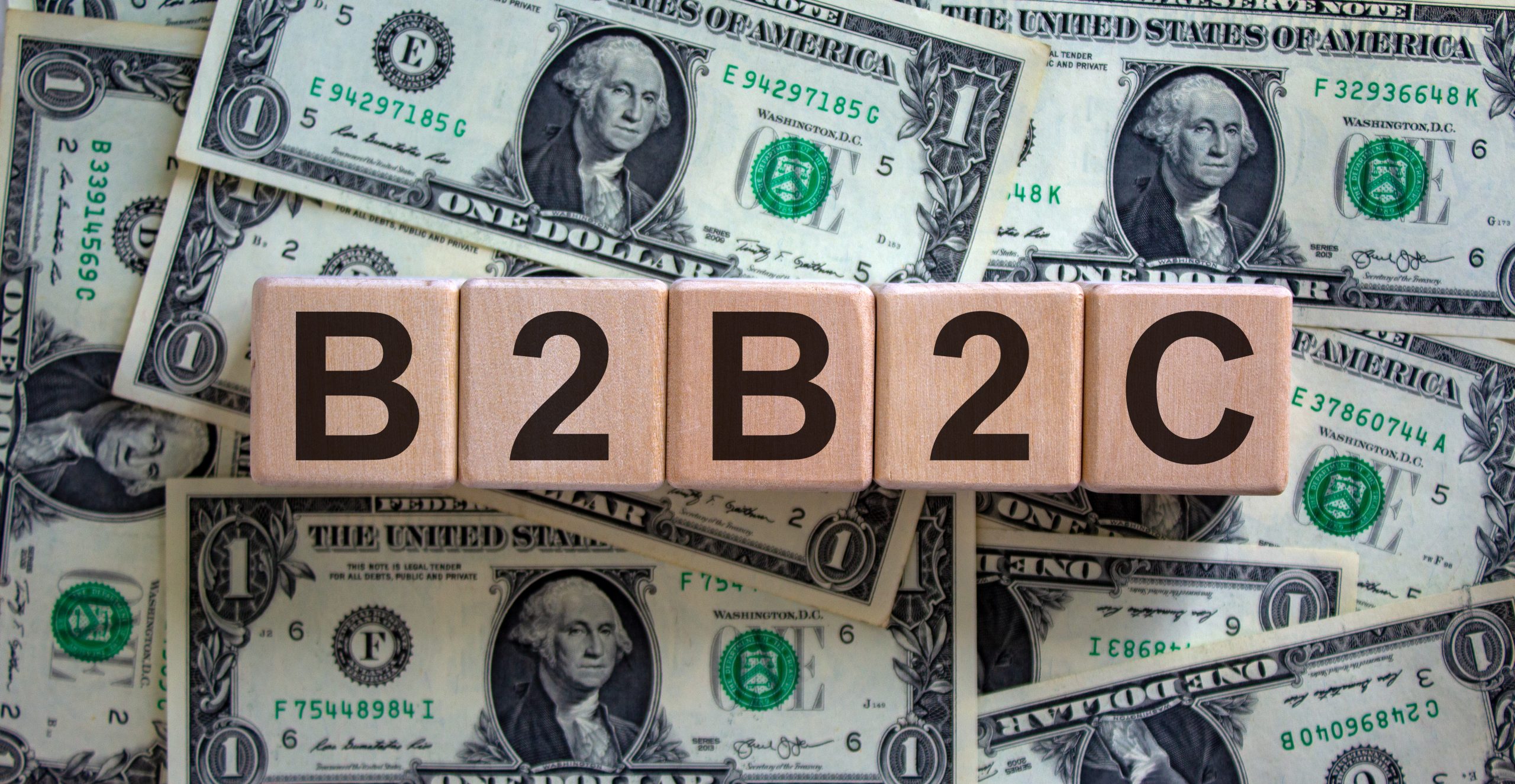B2B2C: What is it, and why does it work?
A B2B2C business model makes it much quicker to get your product to market. Learn all you need to know about B2B2C and how it really works.

Ioana Neamt

So, let’s say you’ve mastered the business model basics. B2B vs. B2C? Nailed it. Subscription vs. freemium? Easy. Direct vs. indirect? Not a problem. But wait, B2B2C? Just when you thought you had all the ecommerce models lodged in your brain, too.
All jokes aside, B2B2C has some similarities with B2B and B2C, but it’s still very much a business model of its own design. It has its own benefits, features, and challenges to consider.

What is B2B2C, anyway?
B2B2C stands for ‘business-to-business-to-consumer.’ It’s a business model where two businesses partner together to provide customers with a combined service. This is usually a service that they can’t efficiently provide on their own.
B2B2C partnerships are very common, even more common than you’d think. A classic example is when a manufacturer provides a product to a retailer. The retailer then provides a platform (like a department store or online marketplace) to sell that product.
Here’s an example. Say you head to Walmart to buy some Bounty Paper Towels (lucky you). That makes you the end customer in a B2B2C chain.
- Bounty is the first business in the chain. They sell the product wholesale to Walmart.
- Walmart is the second business. They help Bounty’s products reach more customers.
- You are the customer at the end of the chain. You buy the product from Walmart (and get your super-absorbent paper towels).
B2B2C and white labeling aren’t the same thing. With white labeling, the business that buys the product from the manufacturer can rebrand it as their own. But with B2B2C, the customer clearly knows they are buying the original provider’s products. It’s an important distinction.
Got that? Great! You now understand the basic B2B2C meaning. Let’s go a bit deeper.
B2B, B2C, B2B2C?
Regardless of the business model you subscribe to, Katana has your back. Katana’s inventory management platform supports all your workflows and helps maintain accurate and efficient inventory.
The B2B2C model explained
In the B2B2C business model, the second company is the ‘link’ in the chain. It provides a service to the first business and a product to the end customer.
What service is the ‘link’ company providing? Imagine this.
You’ve just made the next-best frying pan and want to sell it under a business-to-consumer (B2C) model. That means you need to market that pan and take care of orders and shipping. You’ll also be responsible for handling customer service. In doing so, you’re at risk of spreading your resources a little too thin.
You’d rather avoid that if possible, especially because you’re just starting out in the ruthlessly competitive frying pan market.
Instead, you pitch your product to TJ Maxx. They offer to buy 30,000 pans to sell in their stores. In doing so, TJ Maxx will market and sell the pans to customers on your behalf. All you need to do is keep making your incredible kitchenware.
The B2B2C model offers a more cost-effective way for you to reach your target customers. It also lets you get more exposure without having to spend your entire budget on marketing campaigns. Win-win.
And for TJ Maxx? They make a profit every time they sell one of your products because they bought your pans at wholesale price. You can see now how the B2B2C model is beneficial for both parties.

Pros and cons of the B2B2C model
B2B2C is a beneficial strategy. But it isn’t without its drawbacks. Here’s how the pros stack up against the cons.
Pros
- Each company can use the other company’s resources to achieve growth
- A greater range of products for customers to choose from
- The chance to reach more customers through a retailer or online marketplace
- Collaboration between partners can lead to solutions and innovation
- The opportunity to create complementary products that benefit both parties
- A cheaper route to market for manufacturers
Cons
- The manufacturer often needs to share profits with the partner business
- If one business is over-reliant on the other, this introduces risks
- Businesses may have conflicts with differing objectives and poor communication
- Coordination with inventory management and manufacturing processes can be tough
- Businesses have less agility to respond to market changes
- One business’ brand could overshadow the brand of the other business.

B2B2C Examples
The B2B2C model has use cases in various different industries. Here are a few to consider.
Retail
When explaining the concept of B2B2C, where better to look than the world’s largest online retailer?
Amazon sells ecommerce hosting services to brands and keeps the brand’s products in one of its many warehouses worldwide. In return, Amazon advertises the business’ products through their online marketplace. This gives the business more exposure than they could efficiently achieve on their own. Amazon also handles delivery and customer service.
The App Store
Selling iPhone apps externally is possible but incredibly difficult (on purpose). Most developers have no other choice but to go through the App Store when distributing their next big idea.
This is a mutually beneficial B2B2C partnership. Apple takes a percentage (and a hefty one at 30%) of every sale the developer makes. In return, the developer can advertise their product to a wider audience.
The App Store also inspires trust in consumers, helping to drive more sales. After all, who in their right mind would download a rogue app from a website that didn’t start with apps.apple.com? Malware alert.

Restaurant delivery
Consider a local restaurant that wants to leverage the growing number of people who are ordering takeaways rather than dining out.
They could employ their own fleet of drivers and build a custom app to take orders, but is that really cost-effective? Of course not, especially when DoorDash or Uber Eats could handle the whole thing for them. Best focus on the food and let the experts handle ordering and delivery.

Streamline your B2B2C business operations with Katana
Katana is a cloud inventory software that gives you an overview of every aspect of your business. It makes it easier for you to keep track of your operation, optimize your processes, and stay on top of your B2B2C operation. Here’s how Katana can help to streamline your B2B2C business model.
Inventory management
Katana gives you a real-time overview of your stock levels across multiple locations, including finished goods and raw materials. This ensures you have the right products at the right time, both for your business partners and end consumers. No more stockouts delaying your operation.
Live insights
Katana provides real-time data about sales performance, profit margins, and ongoing costs. Easily identify your top-performing products, keep tabs on customers, and discover inefficiencies in your supply chain.
Tracking features
With Katana, you can track product serial numbers and batches around the world, giving you an overview of your entire supply chain at once. This lets you coordinate more efficiently with your partners and reduce expensive delays.
Integrations
Katana syncs seamlessly with dozens of wholesale integrations. Set up integrations to support shipment tracking, or integrate with a CRM solution like Pipedrive to automate sales pipeline management.

That’s all there is to it.
B2B2C isn’t just a jumble of B2B and B2C. Nor is it one of Frankenstein’s creations. In fact, it can be an extremely beneficial model for businesses that want to get to market faster and for less. When implemented correctly, it can offer you a valuable way to increase exposure without breaking the bank on marketing spend.
Get a demo of Katana today and see how it can help you solve the riddle of B2B2C!

Ioana Neamt
Table of contents
Get inventory trends, news, and tips every month
Get visibility over your sales and stock
Wave goodbye to uncertainty with Katana Cloud Inventory — AI-powered for total inventory control